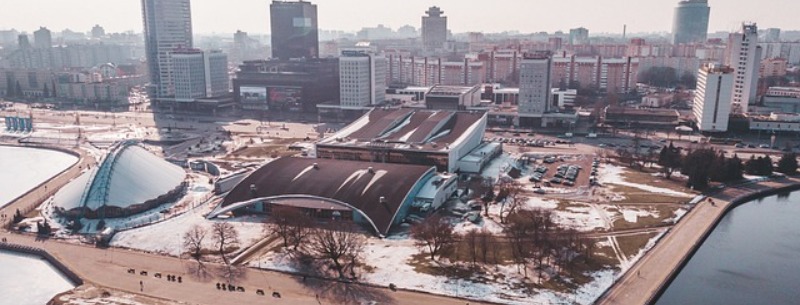Minsk, capital city of Belarus
Minsk is a mind-blowing city that can only be described as communist chic. The capital feels more Soviet than European, locals still talk about spies and the KGB building dominates the landscape. The military and police are ubiquitous around the city, but so are slick new nightclubs, sushi bars and cafes. Minsk is permeated by an almost-tangible pride, the result of triumphantly overcoming the Soviet heyday.
The Belarus National Arts Museum is a great place to begin your exploration of the city. It is the country’s largest museum, featuring over 27,000 works of art in twenty different galleries. Half the museum is dedicated to Belarusian artists while the other half celebrates international works. The Nazis thoroughly looted the collection during the Second World War, but what remains is an impressive testament to Belarusian art and culture.
Belarus is home to numerous beautiful Russian Orthodox and Roman Catholic Churches. One of the most stunning is the Cathedral of the Saint Virgin Mary, built in 1710. Heavily damaged by fire in the late 18th-century and later subject to German and Soviet ownership, the church was renewed once it returned to the Roman Catholics in 1997. The original frescoes were recently restored, and the church remains one of Minsk’s most important landmarks.
The oldest church in the capital, the Saint Peter and Saint Paul Church, stems back to 1613. Superbly restored in the last ten years, the church is a remarkable example of early Belarusian architecture.
Visitors can walk through the country’s turbulent history at the Belarus National Museum of History and Culture. The information panels are only in Belarusian, but it is not hard to find an English-speaking guide in the city. The collection spans the country’s history from ancient times to the present day, featuring folk costumes, manuscripts, agricultural instruments, ritual artifacts and more.
Scores of Soviet soldiers from Belarus were killed in the Afghan war from 1979 until 1989. Their sacrifice is commemorated at the Isle of Tears, a haunting memorial only accessible by a small footbridge in Minsk’s Old Town. The chapel features grave images of widows, mothers and sisters grieving their losses, and a nearby fountain of an angel cries teardrops.
A walk through the Palats Mastatsva reveals the city’s hipper side. Visitors to the district can really get a feel for the city while browsing bookstalls, people-watching from park benches, haggling with antique sellers or admiring modern art.
The modern side of Minsk is most obvious at the National Library of Belarus, an architectural wonder, was built in 1992. The massive collection includes nearly 10 million documents and books and is Belarus’s largest collection. More than 2,000 visitors can find quiet places to read in the library’s 22 floors, and the public observation deck offers unbeatable views of the city.
The National Academic Big Opera and Ballet Theatre of the Republic of Belarus is the city’s cultural heart. Locals shorten the name to just the ìOpierny Teatr,î and the compound and its park are worth a visit whether you have a ticket for a performance or not.
Minsk Geographical Location
Minsk is located in the center of Belarus on the Svislach and Nemiga rivers.
The population of Minsk is approximately 1,850,000 people.
Minsk Language
Belarusian and Russian are the official languages of Belarus with Russian being the most common.
Minsk Predominant Religion
- 80% Eastern Orthodox
- 20% Other
Of the other religions in Belarus Roman Catholic, Protestant, Jewish, and Muslim are the most prominent.
Minsk Currency
The Belarusian Ruble is the official currency of Belarus.
Minsk Climate
Minsk experiences cool summers and cold winters with high humidity. Precipitation is present throughout the year; fog, snow, and rain are quite common.
Minsk Main Attractions
- National Library of Belarus
- Victory Square
- Cathederal of the Holy Ghost
Other Attraction in Minsk
- Island of Tears Monument
- Troetskoye Predmestie (The Old Town)
- St. Maria Magdalene Church
- Museum of the Great Patriotic War
